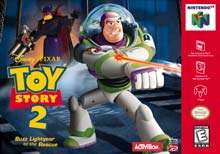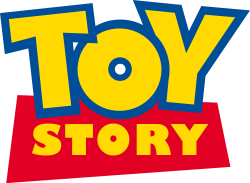Toy Story 2: Buzz Lightyear to the Rescue
| Toy Story 2: Buzz Lightyear to the Rescue | |
|---|---|
 North American Nintendo 64 cover art | |
| Developer(s) |
Traveller's Tales Tiertex Design Studios (GBC) |
| Publisher(s) |
Activision Disney Interactive (PC) THQ (GBC) |
| Composer(s) | Andy Blythe & Marten Joustra |
| Platform(s) | PlayStation, Nintendo 64, Game Boy Color, Dreamcast, Microsoft Windows |
| Release | |
| Genre(s) | Platform |
| Mode(s) | Single-player |
Toy Story 2: Buzz Lightyear to the Rescue (also known as Disney Pixar's Action Game: Toy Story 2) is a platform game based on Pixar's computer animated movie Toy Story 2 and is the sequel to the first Toy Story video game. It was released for the Nintendo 64, PlayStation, Dreamcast, and Microsoft Windows in 1999 and 2000. A different version of the game, titled Toy Story 2, was released for the Game Boy Color on November 22, 1999. A sequel to the game was released 11 years later based on Toy Story 3. It would be re-released as PSOne Classic for PlayStation 3, PlayStation Vita and PlayStation Portable.
Plot
The game's plot is relative to the Toy Story 2 film, and begins at Andy's house as Al McWhiggin steals Woody from the family's yard sale. Buzz Lightyear, Hamm, Rex, Slinky and Mr. Potato Head head out to find and rescue Woody. After leaving Andy's house the toys enter the neighborhood in which Andy lives, then proceed to Al's Toy Barn, the penthouse where Al lives and finally the airport terminal and tarmac where the movie ends. At the end of the game, Buzz has a final battle with Stinky Pete (a.k.a. the Prospector) and two of his in-game henchmen. Contrary to the movie, defeating Stinky Pete is the end of the game.
Gameplay
Console version
The game puts players in control of Buzz Lightyear as he goes across fifteen levels (consisting of ten main levels and five boss levels) based on and inspired by locations from the film in order to rescue Woody. Buzz can attack enemies with a wrist laser, which can be charged up and aimed through a first-person viewpoint, and a spin attack which can also be charged up into a continuous spin. Buzz is also able to extend his wings to perform a double jump, and can perform a butt stomp to activate switches. Players can pick up a laser power-up that gives Buzz a limited supply of powered up laser shots, as well as extra lives and health-replenishing batteries.
The main aim of the game is to collect Pizza Planet tokens which are located throughout stages. Each level has 5 Pizza Planet tokens, which are each collected by completing different objectives, such as fighting a mini-boss, solving a puzzle, completing a timed challenge or winning a race against another character, or helping a character find five of a certain object which are hidden throughout a level. Each level also has a number of coins placed throughout it, 50 of which can be collected and given to Hamm the Piggy Bank for a token. Certain objectives require the use of a special power-up that must first be unlocked in a certain level by retrieving one of Mr. Potato Head's missing body parts. These include a barrier that protects Buzz from damage, rocket boots that launch him at high speeds, a disk launcher that homes in on enemies, a grappling hook for climbing up high ledges, and hover boots for floating up to high places. While only one Pizza Planet token is needed to clear a level, some levels require a certain number of tokens to unlock. With the exception of the Nintendo 64 version, progressing through the game unlocks FMV clips of scenes taken from the film.
Game Boy Color version
A Game Boy Color version of the game, titled Toy Story 2, was released in November 1999. The game is played across eight levels and is a side-scrolling platformer, and utilizes a password feature. Buzz can run and shoot his laser at enemies. Special levels can be accessed if the player collects all the coins located in certain levels.[2][3]
Development
A villain character within the game, who originally donned a mustache, a bullet bandolier and a sombrero, was altered during production after a peaceful demonstration outside Activision's headquarters was carried out by Hispanic activists who perceived the character as an offensive stereotype towards Mexicans.[4]
Reception
| Reception | ||||||||||||||||||||||||||||||||||
|---|---|---|---|---|---|---|---|---|---|---|---|---|---|---|---|---|---|---|---|---|---|---|---|---|---|---|---|---|---|---|---|---|---|---|
| ||||||||||||||||||||||||||||||||||
Toy Story 2: Buzz Lightyear to the Rescue was met with favourable reviews. Aggregating review website GameRankings and Metacritic gave the PlayStation version 75% and 75/100,[5][10] the Nintendo 64 version 62% and 58/100,[6][11] the Dreamcast version 59% and 57/100,[7][12] the Game Boy Color version 57%[8] and the PC version 55%.[9]
Its PlayStation version received a "Gold" sales award from the Entertainment and Leisure Software Publishers Association (ELSPA),[37] indicating sales of at least 200,000 copies in the United Kingdom.[38] According to THQ president and CEO Brian Farrell, the game was a hit for THQ during Q4 of 1999.[39]
See also
References
- 1 2 "Game Guide". Computer Trade Weekly. No. 775. United Kingdom. 4 February 2000. p. 21.
- 1 2 Harris, Craig (17 November 1999). "Toy Story 2 (GBC)". IGN. Retrieved 19 March 2014.
- 1 2 Trueman, Doug (29 February 2000). "Toy Story 2 Review (GBC)". GameSpot. Retrieved 19 March 2014.
- ↑ People Staff (November 26, 1998). "Toy Story 2 Offensive". People. Retrieved April 22, 2018.
- 1 2 "Disney/Pixar Toy Story 2: Buzz Lightyear to the Rescue! for PlayStation". GameRankings. Retrieved 28 February 2013.
- 1 2 "Disney/Pixar Toy Story 2: Buzz Lightyear to the Rescue! for Nintendo 64". GameRankings. Retrieved 28 February 2013.
- 1 2 "Disney/Pixar Toy Story 2: Buzz Lightyear to the Rescue! for Dreamcast". GameRankings. Retrieved 28 February 2013.
- 1 2 "Disney/Pixar Toy Story 2 for Game Boy Color". GameRankings. Retrieved 28 February 2013.
- 1 2 "Toy Story 2 for PC". GameRankings. Retrieved 28 February 2013.
- 1 2 "Toy Story 2: Buzz Lightyear to the Rescue! for PlayStation Reviews". Metacritic. Retrieved 28 February 2013.
- 1 2 "Toy Story 2: Buzz Lightyear to the Rescue for Nintendo 64 Reviews". Metacritic. Retrieved 28 February 2013.
- 1 2 "Toy Story 2: Buzz Lightyear to the Rescue! for Dreamcast Reviews". Metacritic. Retrieved 28 February 2013.
- ↑ Weiss, Brett Alan. "Toy Story 2: Buzz Lightyear to the Rescue (PS) - Review". AllGame. Archived from the original on 13 November 2014. Retrieved 15 September 2015.
- ↑ Wigmore, Glenn. "Toy Story 2: Buzz Lightyear to the Rescue! (N64) - Review". AllGame. Archived from the original on 13 November 2014. Retrieved 15 September 2015.
- ↑ Weiss, Brett Alan. "Toy Story 2 (GBC) - Review". AllGame. Archived from the original on 13 November 2014. Retrieved 15 September 2015.
- ↑ Bell, Jeremy. "Toy Story 2: Buzz Lightyear to the Rescue (DC) - Review". AllGame. Archived from the original on 13 November 2014. Retrieved 15 September 2015.
- ↑ "Toy Story 2: Buzz Lightyear to the Rescue! (PS)". Electronic Gaming Monthly. 1999.
- ↑ "Toy Story 2: Buzz Lightyear to the Rescue! (DC)". Electronic Gaming Monthly. 2000.
- ↑ Buchanan, Levi (12 November 1999). "REVIEW for Toy Story 2 (N64)". GameFan. Archived from the original on 14 June 2000. Retrieved 19 March 2014.
- ↑ "REVIEW for Toy Story 2 (DC)". GameFan. 13 July 2000.
- ↑ "Toy Story 2 (PS)". Game Informer. 28 January 2000. Archived from the original on 27 May 2000. Retrieved 19 March 2014.
- ↑ Reiner, Andrew (24 January 2000). "Toy Story 2 - Nintendo 64". Game Informer. Archived from the original on 26 October 2000. Retrieved 19 March 2014.
- ↑ Helgeson, Matt (29 February 2000). "Toy Story 2 (GBC)". Game Informer. Archived from the original on 17 October 2000. Retrieved 19 March 2014.
- ↑ 2 Barrel Fugue (3 August 2000). "Toy Story 2: Buzz Lightyear to the Rescue! Review for Dreamcast on GamePro.com". GamePro. Archived from the original on 23 March 2005. Retrieved 19 March 2014.
- ↑ Liu, Johnny (November 1999). "Toy Story 2 - Playstation Review". Game Revolution. Archived from the original on 1 March 2000. Retrieved 19 March 2014.
- ↑ Liu, Johnny (August 2000). "Toy Story 2 Review (DC)". Game Revolution. Retrieved 19 March 2014.
- ↑ Liu, Johnny (December 1999). "Toy Story 2 review for the N64". Game Revolution. Archived from the original on 5 July 2008. Retrieved 19 March 2014.
- ↑ Fielder, Lauren (8 December 1999). "Toy Story 2 Review (PS)". GameSpot. Retrieved 19 March 2014.
- ↑ Fielder, Lauren (8 December 1999). "Toy Story 2 Review (N64)". GameSpot. Retrieved 19 March 2014.
- ↑ Lopez, Miguel (18 July 2000). "Toy Story 2 Review (DC)". GameSpot. Retrieved 19 March 2014.
- ↑ Subskin (1 October 2000). "Toy Story 2: Buzz Lightyear to the Rescue". PlanetDreamcast. Archived from the original on 25 January 2009. Retrieved 19 March 2014.
- ↑ Nix, Marc (1 December 1999). "Toy Story 2 (PS)". IGN. Retrieved 19 March 2014.
- ↑ Dunham, Jeremy (10 July 2000). "Toy Story 2 (DC)". IGN. Retrieved 19 March 2014.
- ↑ Casamassina, Matt (12 November 1999). "Toy Story 2 (N64)". IGN. Retrieved 19 March 2014.
- ↑ "Toy Story 2 (N64)". Nintendo Power. 127: 159. December 1999.
- ↑ "Toy Story 2: Buzz Lightyear to the Rescue!". Official U.S. PlayStation Magazine. 2000.
- ↑ "ELSPA Sales Awards: Gold". Entertainment and Leisure Software Publishers Association. Archived from the original on 19 March 2009.
- ↑ Caoili, Eric (November 26, 2008). "ELSPA: Wii Fit, Mario Kart Reach Diamond Status In UK". Gamasutra. Archived from the original on September 18, 2017.
- ↑ "THQ Reports Record Fourth Quarter and 1999 Results". Business Wire. February 23, 2000. Retrieved February 26, 2018.
